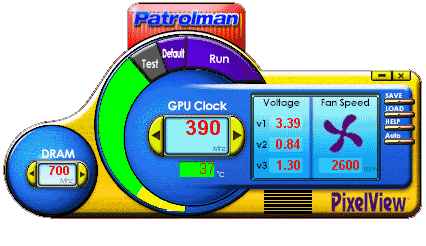CONTENTS
- Videocards' features
- Testbed configurations, test tools, 2D quality
- Test results: Performance
- Conclusions
It is known that GeForce Fx 5900XT based products are very popular now as they combine good performance and a moderate price (roughly equal to RADEON 9600XT). That means they have shifted from the High-End
sector to the Middle one. As we have mentioned before, it really kills NVIDIA's FX 5700 based cards, but that's not the focus of our attention today.
If RADEON 9600XT and FX 5900XT have the same price, it is definitely more sensible to buy the latter. The materials below will fill you in on GeForce FX 5900 (NV35) capabilities in general.
Theoretical materials and videocard reviews concerning NVIDIA GeForce FX GPU functionality
- Analysis of the architecture
of NVIDIA NV30 (GeForce FX)
- NVIDIA GeForce FX
5800 Ultra (NV30) - single-page review
- NVIDIA GeForce FX
5800 Ultra (NV30) - multi-page review
- NVIDIA GeForce FX 5600
Ultra (NV31) and GeForce FX 5200 Ultra (NV34) - single-page
review
- NVIDIA GeForce FX 5600
Ultra (NV31) and GeForce FX 5200 Ultra (NV34) - multi-page review
- ASUS V9900 Ultra on
NVIDIA GeForce FX 5800 Ultra - AA and anisotropy quality
- Gainward FX Powerpack
Ultra/1000 Golden Sample and Gainward FX Powerpack Pro/660 TV/DVI
on NVIDIA GeForce FX 5800 Ultra and 5200 - scaling (performance
vs. CPU clock speed) of GeForce FX 5800 Ultra, performance of GeForce
FX 5200
- Leadtek WinFast
A300 Ultra MyVIVO on NVIDIA GeForce FX 5800 Ultra - performance
of GeForce FX 5800 Ultra vs. CPU clock speed in heavy modes with
AA and anisotropy enabled
- MSI FX5800 Ultra-TD8X
on NVIDIA GeForce FX 5800 Ultra
- Albatron, Chaintech, Gainward,
InnoVision, Leadtek, Palit and Prolink video cards on NVIDIA GeForce
FX 5200
- ASUSTeK NVIDIA GeForce
FX 5200/5600 video cards
- MSI FX5600-VTDR128 (MS-8912)
card on NVIDIA GeForce FX 5600
- Albatron, Leadtek and MSI
video cards on the NVIDIA GeForce FX 5200 Ultra
- Prolink PixelView GeForce FX 5600 256MB
Golden Limited on the NVIDIA GeForce FX 5600
- Gainward FX PowerPack Ultra/760 XP Golden
Sample on the NVIDIA GeForce FX 5900 (new revision)
- AOpen and Soltek cards on NVIDIA GeForce
FX 5600
- Leadtek WinFast A310 Ultra MyVIVO on NVIDIA
GeForce FX 5600 Ultra (350MHz revision)
- ATI vs NVIDIA: where are fair
duels? or Dishonest Treatment of the 3DMark
- MSI FX5900-VTD128 on NVIDIA GeForce FX
5900 - More on 3DMark 2003 (fruits of collaboration of NVIDIA
and FutureMark after signing the peaceful agreement)
- Gainward FX Powerpack Ultra/1200 Golden
Sample on NVIDIA GeForce FX 5900 - performance in NEW game tests,
analysis of performance of the FX 5900 without cheats
- Albatron Gigi GeForce FX 5900PV 128MB
on NVIDIA GeForce FX 5900 Ultra
- Inno3D Tornado GeForce FX5900 128MB on
NVIDIA GeForce FX 5900
- ASUS V9950 Ultra on NVIDIA GeForce FX
5900 Ultra - extremal overclocking
- AOpen Aeolus GeForce FX 5600S 256MB on
NVIDIA GeForce FX 5600
- ABIT, ASUSTeK and Chaintech cards on the
NVIDIA GeForce FX 5600 Ultra
- Gainward Powepack FX Ultra/1600 GS CoolFX on the NVIDIA GeForce
FX 5900 Ultra - Drivers 51.75 beta
- Gainward Powepack FX Ultra/1600 GS CoolFX
on the NVIDIA GeForce FX 5900 Ultra - Drivers 51.75 beta
- Prolink PixelView GeForce FX 5900 128MB
on NVIDIA GeForce FX 5900 - Tomb Raider: Angel of Darkness Benchmark
- NVIDIA GeForce FX 5900SE/XT from Albatron
and Leadtek
- NVIDIA GeForce FX 5950 Ultra (NV38) and
GeForce FX 5700 Ultra (NV36)
- Gigabyte GeForce FX 5950 Ultra 256MB
- drivers 52.70 vs 52.16
- Albatron Gigi GeForce FX 5700 Ultra 128MB
on NVIDIA GeForce FX 5700 Ultra
- Leadtek WinFast A380 Ultra MyVIVO 256MB
and ASUS V9950SE on NVIDIA GeForce FX 5950Ultra/5900SE
- Chaintech GeForce FX 5600XT 128MB 64bit;
Chaintech GeForce FX 5600XT 256MB 128bit; Chaintech GeForce FX 5700
Ultra 128MB; Chaintech GeForce FX 5900 128MB; Chaintech GeForce
FX 5950 Ultra 256MB
- Gainward CoolFX Ultra/1800 XP GS 256MB
on NVIDIA GeForce FX 5950Ultra
- MSI FX5950 Ultra-VTD256 & MSI FX5700
Ultra-TD128 on NVIDIA GeForce FX 5950Ultra/5700Ultra &emdash;
3DMark03 v.340 on drivers 52.16 & 53.0
- NVIDIA GeForce FX 5700 Ultra cards from
AOpen, InnoVision and Sparkl
- ASUS V9570 TD 256MB and ASUS V9560XT/TD
128MB (64bit) on NVIDIA GeForce FX 5700/5600XT
- Gigabyte GeForce FX 5950 Ultra-GT and Gigabyte
GeForce FX 5700 Ultra on NVIDIA GeForce FX 5950/5700
- NVIDIA GeForce FX 5900XT from AOpen, Chaintech
and MSI
- CHAINTECH FX5700 Ultra Apogee AA5700U and
CHAINTECH FX5700 SA5700 128MB on NVIDIA GeForce FX 5700/5700Ultra
- Albatron Gigi GeForce FX 5950 Ultra, ASUS
V9980 Ultra on NVIDIA GeForce FX 5950 Ultra & FarCry DEMO Benchmarking
- Leadtek WinFast A360 Ultra TDH 128MB DDR3
Leadtek WinFast A360LE TD 128MB Prolink PixelView GeForce FX 5700
PDF 256MB based on NVIDIA GeForce FX 5700 Ultra/5700LE/5700 and
FarCry benchmarking
Today we're reviewing a yet another serial card based on FX 5900XT. But it's not an ordinary card, it has its own interesting features and peculiarities.
Prolink has long been known for making products that have their specific "flavour".
And this time as well, the company, besides releasing a standard FX 5900XT, also came up with a Golden Limited version that has a number of peculiarities. I'm not speaking about increased frequencies like in Golden Sample (Gainward), the product has other very interesting features.
Well, I'd like to tell it like it is.
Board
| Prolink PixelView GeForce FX 5900XT
Golden Limited |
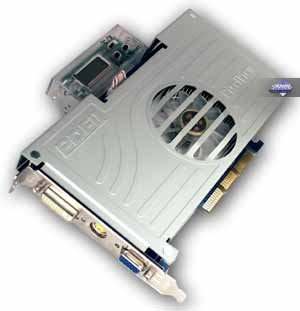
|
|
Prolink PixelView GeForce FX 5900XT Golden Limited
|
|
AGP x8/x4/x2 interface, 128 MB DDR SDRAM allocated in 8 chips on the front side of the PCB.
Hynix memory chips, 2.8ns access time that corresponds to
the actual memory frequency of 350 (700) MHz; 390-MHz GPU frequency, 256-bit memory bus.
|
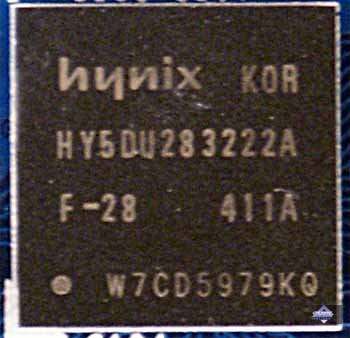
|
| Comparison with the reference design,
front view |
|
Prolink PixelView GeForce FX 5900XT Golden Limited
|
Reference card NVIDIA GeForce FX 5900XT
|
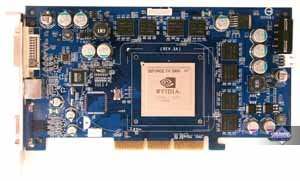
|
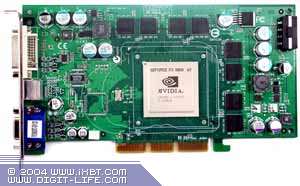
|
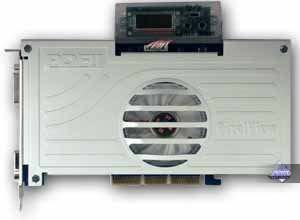
|
| Comparison with the reference design,
back view |
|
Prolink PixelView GeForce FX 5900XT Golden Limited
|
Reference card NVIDIA GeForce FX 5900XT
|
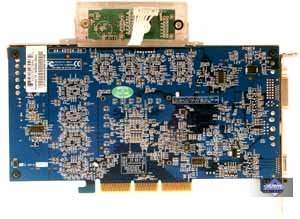
|
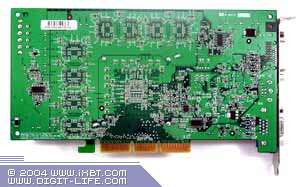
|
Well, what we see here is almost an exact copy of the reference design, although the card has undergone a slight modification so that monitoring can be used. The first thing that catches the eye is not even the shell, but a small display that indicates core temperature and fan rotation frequency.
Before going to a more detailed examination of the PCB, let's take a quick look at the cooling system.
|
Prolink PixelView GeForce FX 5900XT Golden Limited
|
|
We saw a similar thing on a Prolink FX 5700 based card. Interestingly, the shell only serves as a decoration and plays no cooling function here. The memory is not cooled at all and the core has its own massive heatsink with a fan capable of reaching 5000 rpm.
The general view is very beautiful. The only disadvantage is that because of a wide shell the card will be difficult to install on some mainboards that have their capacitors near the AGP slot.
|
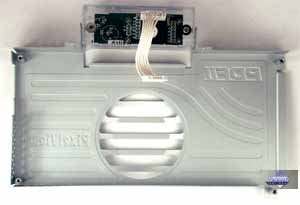
|
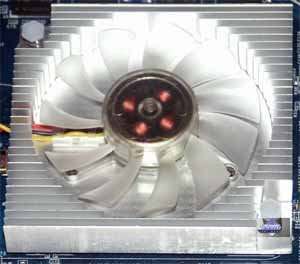
|
The cooler covers an ordinary FX 5900XT :-)
Now let's turn to the card's features. As has been mentioned above, it has a display that indicates core temperature and fan rotating frequency.
The display can be rotated up to 180° so that it will be seen through a transparent case wall.
The bundle also includes a bracket for the 5" bay where this display can be installed and connected to the videocard by means of a supplied extension cable.
Thus, owners of non-transparent cases will be able to monitor the status of their cards too.
The external design, the backlight of the display and the fan produce a very favourable impression of the product. Despite the one-slot-narrow shell, you won't be able to use the first PCI slot for anything, as a prominent heatsink grid will hamper it.
Coming back to monitoring, I'd like to note that the bundle also contains a proprietary utility named PatrolMan that serves for overclocking and monitoring the product's status:
This card could be overclocked to 450/780 MHz. However, it will be reminded that overclocking is a matter of each particular card and one can't make general conclusions basing on just one of them.
By the way, PatrolMan enables to activate automatic overclocking where the frequency changes according to the load (it only concerns 3D). Here is how RivaTuner monitoring responded to such overclocking:
As you can see, the frequency sometimes rose to 425 MHz. It should be noted that automatic overclocking was carried out with NO additional cooling.
Also noteworthy, FX 5900XT had a lower voltage than FX 5950, although it could be raised with the help of drivers in 3D.
Now let's take a look at the bundle.
|
Prolink PixelView GeForce FX 5900XT Golden Limited
|
|
The box includes CDs with software and a DVD player.
It also contains a user manual, S-Video-to-RCA and DVI-to-d-Sub addapters, TV-out extension cables, a cable connecting the display with the videocard, and a 5"-bay bracket.
|
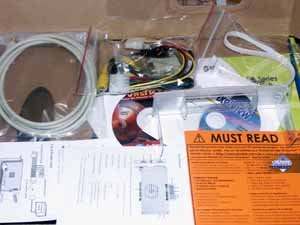
|
And here's the box:
|
Prolink PixelView GeForce FX 5900XT Golden Limited
|
|
The box is made of thick cardboard, has a very attractive design and a slot that enables to see the card.
|
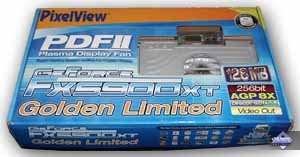
|
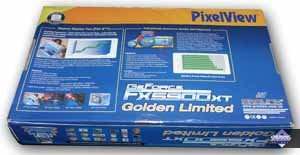
|
Setup and drivers
Testbed configurations:
- Pentium 4 3200 MHz based PC
- CPU: Intel Pentium 4 3200 MHz;
- Mainboard: ASUS
P4C800 Delux on i875P;
- 1024 MB DDR SDRAM;
- HDD: Seagate Barracuda IV 40GB;
- Athlon 64 3200+ based PC
- CPU: AMD Athlon 64 3200+ (L2=1024K);
- Mainboard: ASUS K8V SE Deluxe on VIA K8T800;
- 1 GB DDR SDRAM PC3200;
- HDD: Seagate Barracuda 7200.7 80GB SATA.
- OS: Windows XP SP1; DirectX 9.0b;
- Monitors: ViewSonic P810 (21") and Mitsubishi Diamond Pro 2070sb (21").
- Drivers: ATI version 6.444 (CATALYST 4.5); NVIDIA version 61.11.
VSync is off.
Test results
Before giving an estimate to the 2D quality, I will repeat that there is NO viable method to estimate this parameter objectively for the moment due to the following reasons:
- The 2D quality largely depends on a particular card almost in all actual 3D accelerators;
- The 2D quality depends not only on the videocard but on the monitor and the connecting cable as well;
- The monitor/card liason has had a significant influence on this parameter lately, as there are monitors that are incompatible with certain videocards.
As for the card we tested, the board together with Mitsubishi Diamond
Pro 2070sb demonstrated an excellent quality at the following
resolutions and frequencies:
| Prolink PixelView GeForce FX 5900XT Golden Limited
|
1600x1200x85Hz, 1280x1024x120Hz, 1024x768x100Hz
|
Test results: Performance
These are the tools we used:
- Unreal 2: The Awakening (Infogrames), DirectX 8.1, multitexturing,
the testing was carried out with the help of an auxiliary Bench'emAll! 2.5beta benchmark.
- RightMark 3D (one of the game scenes) — DirectX 8.1,
Dot3, cube texturing, shadow buffers, vertex and pixel shaders (1.1, 1.4).
Test settings: pixel shaders 1.1, shadow buffers are OFF.
- Half-Life2 (Valve/Sierra) — DirectX 9.0, two different demos (ixbt07 and coast).
The testing was carried out with anisotropic filtering enabled.
- Tom Clancy's Splinter Cell v.1.2b (UbiSoft) - Direct3D, Vertex/Pixel Shaders 1.1/2.0, Hardware T&L, maximal quality (Very High); demo 1_1_2_Tbilisi. AntiAliasing doesn't work in the game.
- Call of Duty (MultiPlayer) (Infinity Ward/Activision) — OpenGL, multitexturing, ixbt0104demo, test settings are all maximal, S3TC is ON
- Tomb Raider: Angel of Darkness v.49 (Core Design/Eldos Software) - DirectX 9.0, Paris5_4 demo, test settings are here.
- Fac Cry v.1.1 (Crytek/UbiSoft), DirectX 9.0, multitexturing,
demo01 (startup with the -DEVMODE option), test settings are all Very High.
Those willing to get the demo benchmarks we use, please contact me by e-mail.
Performance
- 1. Call of Duty
- 2. FarCry
- 3. Unreal 2: The Awakening
- 4. Tomb Raider: The Angel of Darkness
- 5. RightMark 3D
- 6. Half Life 2 beta
Conclusions
The test results show that should RADEON 9600XT cost about the same as GeForce FX 5900XT, the latter will be much more preferrable. Although if we take some of the modern applications that use shaders 2.0, they will make FX 5900XT lose even to the lighter-weight ATI rival.
So we can't give a definite answer which product is better. But I think 5900XT's shortcomings can be overbalanced by the pleasant design and the presence of status monitoring.
Unfortunately, Prolink products have become increasingly rare on the Russian market. It is great pity as their quality is very high and the price is quite moderate (sometimes even lower than prices for other products). I can only hope that the above-tested card will appear on our market and vendors won't raise the price too high.
To conclude, Prolink PixelView GeForce FX 5900XT Golden Limited showed very stable work and a high graphic quality. By the way, I wonder why Prolink changed the PCB colour from its traditional yellow to the blue one (it makes me think that the card was made on OEM's order).
You can see more detailed comparisons of various videocards in our
3DiGests.
The card was admitted deserving the "Original Design" award (for June 2004).
11.06.2004
Write a comment below. No registration needed!

